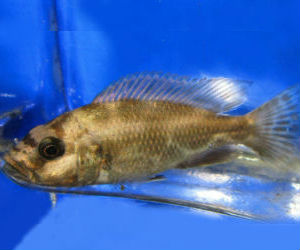
Nimbochromis livingstonii is was formerly called
Haplochromis livingstoni and is now placed in the
genus Nimbochromis where it is the only species. This fairly large cichlid can reach ten inches in length and is endemic to Lake Malawi. This African Rift Lake cichlid is called kalingono which means sleeper. N.livingstonii are ambush predators and have been known to sit idle waiting for prey hence the term sleeper. This species is found in the upper Shire River system and Lake Malombe over sandy substrate areas.
These African cichlids have large mouths and will not hesitate to eat smaller fish so be mindful of tank tank mates. Because males can reach some ten inches with females a few inches smaller a large community tank is beneficial. This species are mouthbrooders and are best kept with multiple females to one male as males are polygamous and will mate with multiple females. They have great colors but their pattern makes them so unique, this species is colored with mottled brown and white which serves as perfect camouflage for its prey. Males can change their color patterns during breeding and exhibit beautiful blue coloration.
Females are said to display the same coloration as males but may have yellow egg spots on their anal fins which is common in African cichlids. It has been suggested the coloration of N.livingstonii cichlids is by design in that they appear as dead fish only to bait potential prey as a hunting strategy, watch the video below to actually see this in action. These laterally compressed fish are known as food fish in their country of origin although they are popular in the aquarium trade among cichlid hobbyists. This species is listed as least concern on the
IUCN Red List for endangered fish due to the main threat to this species being overfishing but a local decline has been recorded due to the commercial trawl fishery.

Nimbochromis livingstonii videos


